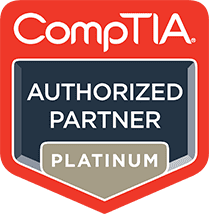BONUS! Cyber Phoenix Subscription Included: All Phoenix TS students receive complimentary ninety (90) day access to the Cyber Phoenix learning platform, which hosts hundreds of expert asynchronous training courses in Cybersecurity, IT, Soft Skills, and Management and more!
Course Overview
Our 5-day instructor-led Linux+ training and certification boot camp in Washington, DC Metro, Tysons Corner, VA, Columbia, MD or Live Online will help anyone looking to pursue or further their career working with Linux-based technologies. Businesses are quickly noticing that Linux provides an economic and practical solution to fulfilling their business needs; the system continues to make exponential growth the mainstream IT infrastructure market. Many large companies such as IBM, Dell, HP, Xerox and Lenovo either recommend or require the Linux+ certification.
Schedule
CompTIA Linux+
date
location
price
![[image]](https://phoenixts.com/wp-content/themes/phoenixts-com/assets/images/temp/image-9@2x.jpg)
Not seeing a good fit?
Let us know. Our team of instructional designers, curriculum developers, and subject matter experts can create a custom course for you.
Learn more about custom training
Program Level
Intermediate
Training Delivery Methods
Group Live
Duration
5 Days / 32 hours Training
CPE credits
26 NASBA CPE Credits
Field of Study
Information Technology
Advanced Prep
N/A
Course Registration
Candidates can choose to register for the course by via any of the below methods:
- Email: Sales@phoenixts.com
- Phone: 301-582-8200
- Website: www.phoenixts.com
Upon registration completion candidates are sent an automated course registration email that includes attachments with specific information on the class and location as well as pre-course study and test preparation material approved by the course vendor. The text of the email contains a registration confirmation as well as the location, date, time and contact person of the class.
Online enrolment closes three days before course start date.
On the first day of class, candidates are provided with instructions to register with the exam provider before the exam date.
Complaint Resolution Policy
To view our complete Complaint Resolution Policy policy please click here: Complaint Resolution Policy
Refunds and Cancellations
To view our complete Refund and Cancellation policy please click here: Refund and Cancellation Policy
Course Outline
Preparing Your Environment
- Setting Up a Learning Space
- Exploring Linux Distributions
- Locating a Terminal
Sifting Through Services
- What is a Linux Server?
- Serving the Basics
- Serving Local Networks
- Implementing Security
- Improving Performance
Managing Files, Directories, and Text
- Handling Files and Directories
- Linking Files and Directories
- Reading Files
- Finding Information
Searching and Analyzing Text
- Processing Text Files
- Redirecting Input and Output
- Editing Text Files
Explaining the Boot Process
- The Linux Boot Process
- The Firmware Startup
- Linux Bootloaders
- System Recovery
Maintaining System Startup and Services
- Looking at init
- Managing systemd Systems
- Managing SysV init Systems
- Digging Deeper into systemd
Configuring Network Connections
- Configuring Network Features
- Basic Network Troubleshooting
- Advanced Network Troubleshooting
Comparing GUIs
- Focusing on the GUI
- Serving Up the GUI
- Using Remote Desktops
- Forwarding
Adjusting Localization Options
- Understanding Localization
- Setting Your Locale
- Looking at Time
Administering Users and Groups
- Managing User Accounts
- Managing Groups
- Setting Up the Environment
- Querying Users
- Managing Disk Space Usage
Handling Storage
- Storage Basics
- Partitioning Tools
- Understanding Filesystems
- Formatting Filesystems
- Mounting Filesystems
- Managing Filesystems
- Storage Alternatives
Protecting Files
- Understanding Backup Types
- Looking at Compression Methods
- Comparing Archive and Restore Utilities
- Securing Offsite/Off-System Backups
- Checking Backup Integrity
Governing Software
- Working with Source Code
- Packaging Applications
Tending Kernel Modules
- Exploring Kernel Modules
- Installing Kernel Modules
- Removing Kernel Modules
Applying Ownership and Permissions
- Looking at File and Directory Permissions
- Access Control Lists
- Context-Based Permissions
- Understanding Linux User Types
- Restricting Users
Looking at Access and Authentication Methods
- Getting to Know PAM
- Exploring PKI Concepts
- Using SSH
- Using VPN as a Client
Implementing Logging Services
- Understanding the Importance of Logging
- Basic Logging Using rsyslog
- Journaling with systemd-journald
Overseeing Linux Firewalls
- Providing Access Control
- Looking at Firewall Technologies
- Forwarding IP Packets
- Dynamically Setting Rules
Embracing Best Security Practices
- User Security
- System Security
- Network Security
Analyzing System Properties and Remediation
- Troubleshooting the Network
- Troubleshooting Storage Issues
- Troubleshooting the CPU
- Troubleshooting Memory
- Surviving a Lost root Password
Optimizing Performance
- Looking at Processes
- Monitoring Processes in Real Time
- Managing Processes
Investigating User Issues
- Troubleshooting Access
- Examining File Obstacles
- Exploring Environment and Shell Issues
Dealing with Linux Devices
- Communicating with Linux Devices
- Working with Devices
- Using Hot Pluggable Devices
Troubleshooting Application and Hardware Issues
- Dealing with Storage Problems
- Uncovering Application Permission Issues
- Analyzing Application Dependencies
- Looking at SELinux Context Violations
- Exploring Firewall Blockages
- Troubleshooting Additional Hardware Issues
Deploying Bash Scripts
- The Basics of Shell Scripting
- Advanced Shell Scripting
- Writing Script Programs
Automating Jobs
- Running Scripts in Background Mode
- Running Scripts Without a Console
- Sending Signals
- Job Control
- Running Like Clockwork
Controlling Versions with Git
- Understanding Version Control
- Setting Up Your Git Environment
- Committing with Git
- Merging Versions
Understanding Cloud and Virtualization Concepts
- Considering Cloud Services
- Understanding Virtualization
- Exploring Containers
Inspecting Cloud and Virtualization Services
- Focusing on VM Tools
- Understanding Bootstrapping
- Exploring Storage Issues
- Considering Network Configurations
Orchestrating the Environment
- Understanding Orchestration Concepts
- Provisioning the Data Center
- Looking at Container Orchestration Engines
CompTIA Linux+ Exam XK0-004
Exam Details:
- Number of Questions: Maximum of 90
- Passing Score: 720 on scale of 100-900
- Duration: 90 minutes
- Format: multiple choice and performance-based
- Delivery: Pearson VUE
| Objectives | % of Exam |
| Hardware and System Configuration | 21% |
| Systems Operations and Maintenance | 26% |
| Security | 19% |
| Linux Troubleshooting and Diagnostics | 20% |
| Automation and Scripting | 14% |
Finance your Linux+ Training!
We have partnered with Meritize to provide our students with financing options to fund your education.Check your loan options in minutes without impacting your credit score. Click here to apply
FAQs
Web Administrators
Linux Database Administrators
Networking Students
Junior Linux Administrators
Junior Network Administrators
Systems Administrators
Students should have at least six months of practical work experience with Linux systems, CompTIA A+ and Network+ certifications or hold equivalent experience and knowledge.
Examples include Dell, General Dynamics, Booz Allen Hamilton, Aetna, the U.S. Navy, and the Department of Defense.
As of March 2021 the exam costs $338 if purchased separate from a course.
Yes, Linux+ does require certification renewal every three years. To renew, certification holders must 50 continuing education units (CEUs) through completing activities as specified by the CompTIA Continuing Education program.
CompTIA Linux+ Resources
-
Blog Post
PHOENIX TS NOW OFFERS EMERGING TECH TRAINING AS AN AUTHORIZED TRAINING PARTNER WITH CERTNEXUS
-
Blog Post
Phoenix TS and Alliance Cyber Announce Strategic Partnership to Deliver Comprehensive Training Services Nationwide
-
Blog Post
Phoenix TS Took To San Diego For CIC 2023: Highlights From The Conference And What Comes Next
-
Blog Post
Cybersecurity Mindful Moments by Tara Lemieux
-
Blog Post
CompTIA and Continuing Education (CE’s)
-
Blog Post
Boost your Cyber Security Awareness
-
Blog Post
Why You Should Invest in Cyber Security
-
Blog Post
Diversity: A Tough Topic Worth Tackling
-
Blog Post
Benefits and Advantages of Instructor-Led Courseware
-
Blog Post
Data, Data, and more Data!!!
-
Blog Post
Be Prepared for Anything with EDRP
-
Blog Post
Learn How to Make Your Dream Business a Reality
-
Blog Post
The FYI ABOUT PMP from PMI
-
Blog Post
STRENGTHEN YOUR CYBERCORE!
-
Blog Post
Security + Changes!
-
Blog Post
What’s the 411 with the updated CySA+?
-
Blog Post
How to Maintain Team Building While Working Remotely!
-
Blog Post
All About the CISSP
-
Blog Post
Get CCNA-ready in 2020!
-
Blog Post
IT Project Managers, a career of keeping business IT on track!
-
Blog Post
Jira – The Godzilla of Team Support Tools!
-
Blog Post
What’s All the Buzz Around Microsoft Azure?
-
Blog Post
Get the E-Book!
-
Blog Post
The Adobe Connect Way!
-
Blog Post
Train, Test and Certify From Home!
-
Blog Post
Critical Thinking in the Workplace
-
Blog Post
Are you Teleworking Now? Watch out. Cybersecurity risks are everywhere!
-
Blog Post
Everything you wanted to know about the Security+ SY0-601 but were afraid to ask!
-
Blog Post
Hey Remote Worker! You Better be Using Email Best Practices
-
Blog Post
Head in the Cloud? Time to Face Cyber Security Reality
-
Blog Post
Companies use COVID-19 Downtime to Educate their Workforce Online
-
Resource
CompTIA Linux+ Assessment
-
Blog Post
CompTIA Stackable Certifications
-
Blog Post
Top Linux Certifications [2017]
-
Blog Post
Installing Arch Linux on VirtualBox
-
Blog Post
Why You Should and Shouldn’t Get a Linux+ Certification
-
Blog Post
Aliases in Linux
-
Blog Post
Environment Variables in Linux
-
Blog Post
Learn to Pen Test with Kali Linux
-
Blog Post
CompTIA Linux+ Exam: User Interfaces and Desktops
-
Blog Post
What Do I Need to Know to Pass the Linux+ Exam LX0-104?
-
Blog Post
Where to Find Free Books for Learning Linux Online
-
Blog Post
Linux Text-Based Web Browsers
-
Blog Post
9 YouTube Channels to Learn Linux Online
-
Blog Post
What do I need to know to pass the first Linux+ Exam LX0-103?
-
Blog Post
Build AUR Packages in Arch Linux with makepkg or yaourt
-
Blog Post
What are the CompTIA Linux+ Certification Changes?
-
Blog Post
7 Linux Applications for Your Desktop
-
Blog Post
Full Arch Linux System Installation Guide in 29 Steps
-
Blog Post
3 Linux Certifications That Help Linux Systems Administrators
-
Blog Post
18 Items for Your Linux Admin Toolkit
-
Blog Post
8 Essential Linux Admin Tools for Debian-Based Systems
-
Blog Post
Network Configuration in Linux
-
Blog Post
Are Linux Certifications Worth it?
-
Blog Post
Why did the HoCo Library Ditch Windows for Linux?
BONUS! Cyber Phoenix Subscription Included: All Phoenix TS students receive complimentary ninety (90) day access to the Cyber Phoenix learning platform, which hosts hundreds of expert asynchronous training courses in Cybersecurity, IT, Soft Skills, and Management and more!
Phoenix TS is registered with the National Association of State Boards of Accountancy (NASBA) as a sponsor of continuing professional education on the National Registry of CPE Sponsors. State boards of accountancy have final authority on the acceptance of individual courses for CPE credit. Complaints re-garding registered sponsors may be submitted to the National Registry of CPE Sponsors through its web site: www.nasbaregistry.org


![[GSA LOGO]](https://phoenixts.com/wp-content/themes/phoenixts-com/assets/images/gsa-logo-black.png)
